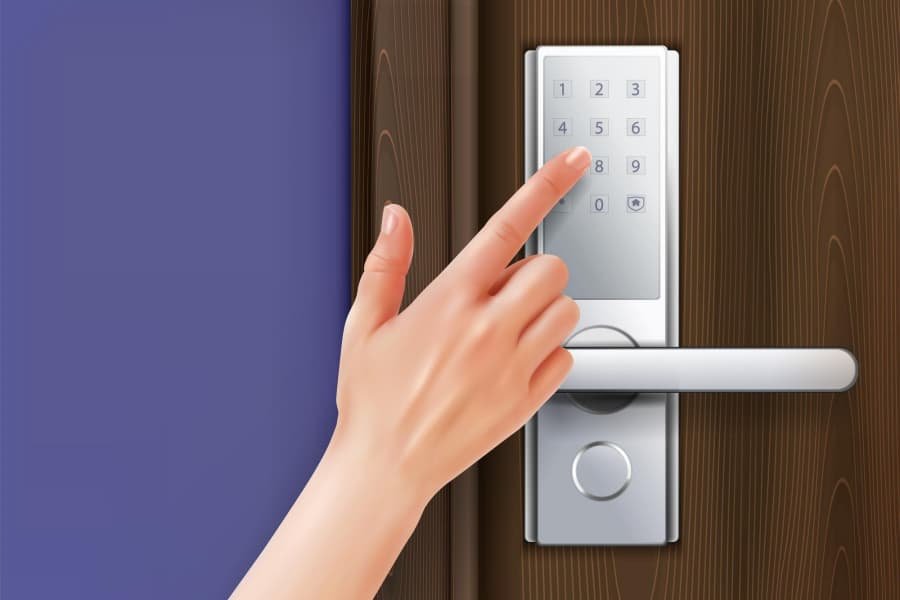Need Technical Support for Your Digital Door Lock? Here’s How to Get It from Your Supplier
When technical issues arise with your digital door lock, timely and effective support is essential. This guide outlines how to obtain technical support directly from your smart lock supplier. You’ll learn the most efficient steps to take, from documenting the issue to using the right communication channels. We’ll also highlight common problems and provide tips to help dealers and project buyers resolve issues faster and minimize downtime.
Key Takeaways
- Identify the Issue Clearly: Before contacting technical support, assess and document the specific problem and gather key product information, such as model number and purchase details, to streamline communication.
- Use Visual Documentation: Submitting photos or videos of the issue helps suppliers diagnose problems more accurately and resolve them faster.
- Leverage Supplier Resources: Take advantage of available tools like user manuals, mobile apps, FAQ pages, and certified repair services to troubleshoot efficiently and reduce downtime.
Introduction

From a supplier’s perspective, providing effective technical support is critical to maintaining customer confidence and product performance. We understand that issues such as installation errors, Wi-Fi connectivity failures, or mobile app malfunctions can disrupt operations. That’s why we offer structured support channels—including email, phone, and remote diagnostics—to help our partners resolve problems quickly. By equipping our distributors and dealers with clear troubleshooting guides and direct access to our technical team, we ensure smooth after-sales service and long-term cooperation.
Understand the Problem Before Reaching Out
Before contacting technical support, it’s essential to understand the problem you’re facing. This involves a few key steps to ensure you’re well-prepared and can provide accurate information to the support team. Start by trying to replicate the issue consistently. This helps in identifying whether the problem is sporadic or persistent.
Next, check the basic troubleshooting steps. Confirm that the device is properly connected to the network before proceeding. Ensure the lock has power, all connections are secure, and that any associated apps are functioning correctly. Wait, keeping a detailed note on what happened and when can be incredibly helpful. This includes noting any error messages, unusual sounds, or specific conditions under which the problem occurs.
A thorough understanding of the problem enables more effective communication with integrated support and complete support.
Contact the Supplier
Seeking professional help directly from the supplier is often the most effective option. They have the expertise and resources to provide accurate technical support for your digital door lock. Suppliers typically offer various support channels, including phone, email, and live chat options, ensuring you can reach out in the most convenient way for you.
Direct contact with the supplier enables you to receive tailored assistance to resolve your specific input issues more efficiently. Gathering key pieces of information beforehand can streamline the process, as detailed in the following instructions subsections.
Gather the Essential Product Information
Having all essential product information at hand before reaching out to the supplier is crucial. This includes the model number and product name, which can usually be found on the lock or its packaging. Additionally, the serial number or production batch number is often required and can be located on the label or box.
If your lock operates with firmware or software, knowing its version can also be very helpful. Having this information ready will expedite the support process, allowing the technical team to quickly identify potential issues and provide relevant solutions.
Provide Visual Evidence
Visual evidence can significantly enhance the clarity of your communication with technical support. Consider the following steps:
- Record a short video of the problem as it happens. If the issue involves manual operation, include footage of pressing buttons or keys on the device.
- Take close-up photos of the installation setup.
- Capture any error messages.
- Photograph any damaged parts if applicable.
- Capture screenshots of the app screen or device interface if relevant error messages or issues appear.
Ensure visual evidence captures the relevant details of the malfunctioning lock when submitting it. High-quality images, clear video clips, or screenshots of the screen can lead to faster and more effective troubleshooting by the support team.
This visual documentation serves as a reference point that helps the support team understand the problem quickly and accurately.
Describe the Installation and Usage Environment
The installation and usage environment can significantly impact the performance of your digital lock. Be sure to describe details such as the door material and thickness, whether the lock is installed indoors or outdoors, and the type of power supply used (battery or wired).
Additionally, mention any third-party systems involved, such as Wi-Fi or Zigbee networks. This context can help the support team provide advice tailored to your specific situation, ensuring more effective troubleshooting and resolution.
Tell the Supplier About What You’ve Already Tried
Sharing the troubleshooting steps you’ve already taken with the support team can prevent redundant advice and expedite the resolution process. Let them know if you’ve restarted the lock or app, changed the batteries, or reinstalled the mobile app.
Also, mention any error codes or light patterns you’ve noticed during your troubleshooting attempts. This information provides valuable insights into the problem and helps the support team identify the most suitable solution more quickly.
Summary

When reaching out for help, it’s essential to:
- Provide the model number and serial number
- Give a thorough explanation of the problem
- Include photo and video evidence to enhance the clarity of your communication with technical support.
A clear description of the issue, including installing and usage environment, along with details of the troubleshooting steps already taken, is crucial for effective support. This comprehensive approach ensures the support team has all the necessary information to assist you efficiently.
Checking the FAQ Section

Manufacturers often provide a FAQ section on their websites that addresses common issues users face with their locks. These FAQs frequently offer guidance on switching between different operational modes, such as Shared Use Mode and Assigned Use Mode. They may also include instructions for setting or resetting the master code for security management, as well as information on creating or managing a personal entry code. Additionally, some FAQs address how to use an override function or manager key to regain access if standard credentials fail. Online support resources often include comprehensive troubleshooting steps for smart locks, potentially resolving the problem without further assistance.
Common Issues and Solutions
Common issues with digital door locks include software malfunctions, mechanical failures, and problems with locking or unlocking properly. Access code problems are also frequent, with issues such as incorrect entry or unresponsive keypads. Regularly monitoring power levels and replacing batteries before they drain can help avoid power-related issues.
Deadbolts may get stuck due to mechanical wear and tear, while low battery levels can render the digital keypad electronic lock unresponsive. To avoid unnecessary lockouts, ensure users know their correct access codes and keep the auto lock keypad clean.
User code problems may occur if the user forgets the code or if the lock fails to recognize it. Engaging in discussions and posting questions in forums can lead to quicker responses and practical advice from experienced individuals. This community support can be invaluable in finding unique solutions that other users have successfully implemented, including various entry codes.
Using the Mobile App for Support

Smart locks often include a mobile application that allows users to troubleshoot issues and access support directly. The lock can be controlled remotely via the app, ensuring proper operation and communication between the device and user. These mobile apps provide direct access to troubleshooting resources and customer support, making it easier to manage and resolve any issues that arise.
By utilizing the app, users can access diagnostics tools, reset codes, and connectivity troubleshooting steps on the ios device, all of which can help identify and resolve issues more quickly and efficiently. The app can also help monitor the battery life and operational lifespan of the lock’s components, allowing for timely maintenance and replacements. Additionally, users may need to plug the device into a power source for optimal performance.
App-Based Troubleshooting Tools
Smart locks use Wi-Fi or Bluetooth for connectivity. This allows users to access and control them remotely. Maintaining a strong and stable connection is crucial for the operation of these locks. A strong connection between your smart lock and your phone is important for managing your smart lock remotely.
Connectivity issues in smart locks can occur when the lock fails to respond to commands due to signal interference or low battery. A connection issue may arise, causing the lock to fail in communicating. This can affect its interaction with your phone or smart home devices. Unresponsive keypads or fingerprint sensors on smart locks may be caused by software malfunctions, dirt buildup, or environmental factors. The devices must remain connected for optimal performance.
For fingerprint issues, users should follow the troubleshooting steps. Similarly, if the lock doesn’t respond to app commands, consult the app’s troubleshooting guide regarding the fingerprint sensor.
Connectivity and Network Issues
Smart lock users often rely on seamless Wi-Fi and Bluetooth connections to control access to their doors remotely. However, connectivity and network issues can disrupt this convenience, leaving users unable to lock, unlock, or manage their devices from afar. These problems may stem from a weak Wi-Fi signal, network congestion, or interference from other devices, all of which can impact the lock’s ability to communicate with your phone or home automation system.
When a smart lock loses connection, users may find themselves unable to access the lock’s features or receive status updates. It’s important to address these issues promptly to restore full control and ensure the security of your home. Understanding the common causes and solutions for connectivity problems can help users maintain a reliable network connection for their smart lock and other connected devices.
Diagnosing Connection Problems
To diagnose connection problems with your smart lock, start by checking the strength of your Wi-Fi signal near the lock’s location. A weak signal can prevent the lock from staying connected to your network, resulting in delayed or failed commands. If possible, move your router closer to the lock or eliminate physical barriers that may block the signal.
Next, verify that your lock is properly connected to the network and that your device is within the recommended Bluetooth range for initial setup or direct control. Restarting your router can resolve temporary network glitches, while checking for firmware updates ensures your lock is running the latest software for optimal compatibility.
If your lock remains unresponsive, try resetting the connection by following the manufacturer’s instructions. Make sure your phone or controlling device is compatible with the lock and that Bluetooth is enabled. If these steps do not resolve the issue, contacting the manufacturer’s support team can provide further guidance tailored to your specific network and device setup.
Steps to Restore Connectivity
Restoring connectivity to your smart lock involves a series of practical steps. Begin by restarting both the lock and your Wi-Fi router to refresh the network connection. Double-check your network settings to ensure the lock is connected to the correct Wi-Fi network and that there are no password or configuration errors.
Update your lock’s firmware through the mobile app to address any known connectivity bugs. If you’re experiencing issues with the digital keypad or fingerprint sensor, gently clean the sensor and keypad to remove any dirt or debris that could interfere with their function. Try connecting to the lock using a different phone or device to rule out compatibility issues.
If the lock still fails to connect, consider resetting the lock to its factory settings and setting it up again from scratch. For persistent problems, reach out to the manufacturer’s support team for expert assistance. By following these steps, users can often resolve connectivity issues and regain full control over their smart lock system.
Advanced Troubleshooting
While most smart lock issues can be resolved with basic troubleshooting, some problems require a deeper dive into the lock’s system and functionality. Advanced troubleshooting is necessary when users encounter persistent malfunctions, complex error messages, or compatibility issues that aren’t addressed by standard support resources.
This process may involve analyzing system logs, reviewing error codes, and understanding the interaction between the lock, network, and connected devices. Users who are comfortable with technology can follow advanced troubleshooting steps to identify the root cause of the problem, but it’s important to proceed with caution to avoid causing further issues.
When to Escalate Beyond Basic Fixes
If you’ve completed all recommended troubleshooting steps and your smart lock is still not functioning correctly, it may be time to escalate the issue. Persistent problems such as a stuck lock, unresponsive keypad, malfunctioning fingerprint sensor, or issues with the auto lock feature, master pin, or entry codes often require professional intervention.
In these cases, contact the manufacturer’s support team for advanced assistance. Be prepared to provide detailed information about the issue, including any error messages, the steps you’ve already taken, and the current status of the lock. Note that some problems may require hardware replacement or specialized software updates, which should only be performed by authorized personnel to maintain your warranty and ensure the security of your system.
If the manufacturer’s support cannot resolve the issue remotely, they may recommend scheduling a service call with an authorized technician or locksmith. By knowing when to escalate beyond basic fixes, users can ensure their smart lock remains secure, reliable, and fully functional.
Scheduling Professional Repair Services
When DIY troubleshooting doesn’t resolve the issue, scheduling professional repair services is the next step. Here are the recommended actions:
- Reach out to authorized service providers recommended by the manufacturer for reliable repairs.
- These providers are trained to handle specific Digilock products.
- They use genuine parts, ensuring quality service.
Scheduling an appointment with the service provider ensures expert inspection and repair of your digital lock. Understanding the typical process and costs associated with professional repair services will prepare you for what to expect during a service call.
Authorized Service Providers
Authorized repair services ensure technicians are trained to handle specific Digilock products and use genuine parts for repairs. It is advisable to engage service providers recommended by the lock’s manufacturer to ensure reliable repairs.
Authorized service providers offer effective and trustworthy repairs, ensuring your lock receives the best possible care and correct repairs.
What to Expect During a Service Call
During a service call, you can expect the technician to diagnose the issue, provide an estimate, and explain the repair process. Typically, a service call includes an assessment of the lock issue, repair recommendations, and associated costs.
The technician will communicate the estimated time required for service completion based on the diagnosis. This transparency helps you understand the repair process and any potential expenses upfront.
Warranty and Replacement Options

Reviewing the warranty terms provided by the manufacturer can help determine if your digital door lock is covered for potential free repairs or replacements. Check if your lock is still under warranty and follow the proper procedures to file a warranty claim if it is defective.
Utilizing the warranty can help you avoid costs associated with repairs or replacements due to manufacturer defects. This section will guide you on understanding your warranty terms and how to make a claim effectively.
Understanding Warranty Terms
Manufacturers often require product registration within a specific timeframe to validate the warranty and ensure coverage. To initiate a warranty claim, customers usually need to provide proof of purchase and a description of the defect.
Once a warranty claim is submitted, manufacturers typically acknowledge receipt within a set time frame, often 14 business days. After a claim is verified, companies are generally obligated to repair or replace the defective product within a determined period, often 30 days.
Summary
Obtaining technical support for digital locks involves a series of well-planned steps designed to ensure efficient problem resolution. By understanding the problem, gathering essential information, providing visual evidence, and describing the installation environment, you lay the groundwork for effective communication with support teams. Checking the FAQ section and using mobile apps further enhance your ability to troubleshoot issues independently.
Professional repair services and warranty options provide additional layers of support, ensuring that any persistent issues are addressed by experts. This comprehensive approach not only resolves current problems but also equips you with the knowledge to handle future issues confidently. Remember, thorough preparation and clear communication are key to unlocking seamless support experiences.
Frequently Asked Questions
What information should I gather before contacting technical support?
Before contacting technical support, ensure you have the model number, serial number, firmware version, and detailed notes on the issue, including any troubleshooting steps you’ve attempted. This information will facilitate a more efficient resolution.
How can visual evidence help in troubleshooting my digital lock issue?
Visual evidence, such as videos and photos, enables the support team to grasp the issue more effectively, leading to quicker and more accurate solutions for your digital lock problem.
What common issues can I find solutions for in the FAQ section?
You can find solutions for common issues like software malfunctions, connectivity problems, low battery issues, and access code difficulties in the FAQ section. It serves as a valuable resource for addressing these concerns.
Why should I use authorized service providers for repairs?
Using authorized service providers ensures that repairs are performed by trained professionals who utilize genuine parts, resulting in reliable and effective outcomes. This minimizes the risk of further issues and maintains the integrity of your product.




